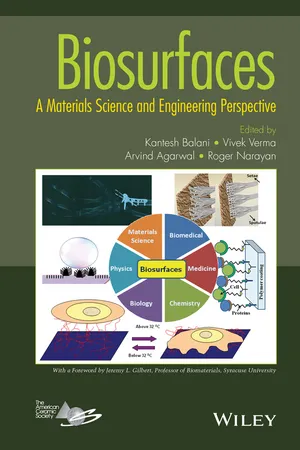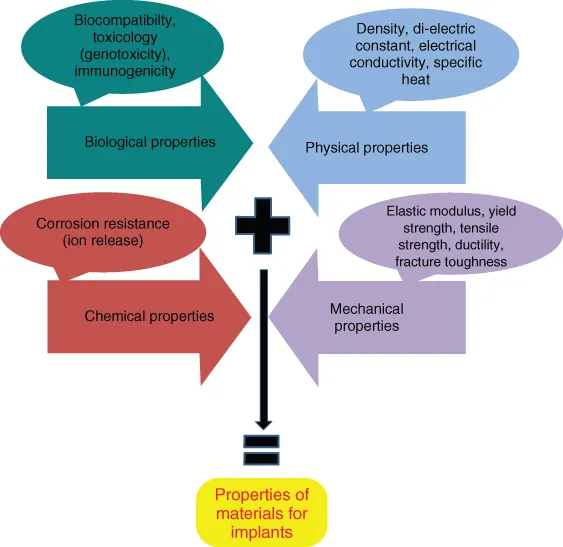
eBook - ePub
Biosurfaces
A Materials Science and Engineering Perspective
- English
- ePUB (mobile friendly)
- Available on iOS & Android
eBook - ePub
Biosurfaces
A Materials Science and Engineering Perspective
About this book
Ideal as a graduate textbook, this title is aimed at helping design effective biomaterials, taking into account the complex interactions that occur at the interface when a synthetic material is inserted into a living system. Surface reactivity, biochemistry, substrates, cleaning, preparation, and coatings are presented, with numerous case studies and applications throughout.
Highlights include:
- Starts with concepts and works up to real-life applications such as implantable devices, medical devices, prosthetics, and drug delivery technology
- Addresses surface reactivity, requirements for surface coating, cleaning and preparation techniques, and characterization
- Discusses the biological response to coatings
- Addresses biomaterial-tissue interaction
- Incorporates nanomechanical properties and processing strategies
Frequently asked questions
Yes, you can cancel anytime from the Subscription tab in your account settings on the Perlego website. Your subscription will stay active until the end of your current billing period. Learn how to cancel your subscription.
At the moment all of our mobile-responsive ePub books are available to download via the app. Most of our PDFs are also available to download and we're working on making the final remaining ones downloadable now. Learn more here.
Perlego offers two plans: Essential and Complete
- Essential is ideal for learners and professionals who enjoy exploring a wide range of subjects. Access the Essential Library with 800,000+ trusted titles and best-sellers across business, personal growth, and the humanities. Includes unlimited reading time and Standard Read Aloud voice.
- Complete: Perfect for advanced learners and researchers needing full, unrestricted access. Unlock 1.4M+ books across hundreds of subjects, including academic and specialized titles. The Complete Plan also includes advanced features like Premium Read Aloud and Research Assistant.
We are an online textbook subscription service, where you can get access to an entire online library for less than the price of a single book per month. With over 1 million books across 1000+ topics, we’ve got you covered! Learn more here.
Look out for the read-aloud symbol on your next book to see if you can listen to it. The read-aloud tool reads text aloud for you, highlighting the text as it is being read. You can pause it, speed it up and slow it down. Learn more here.
Yes! You can use the Perlego app on both iOS or Android devices to read anytime, anywhere — even offline. Perfect for commutes or when you’re on the go.
Please note we cannot support devices running on iOS 13 and Android 7 or earlier. Learn more about using the app.
Please note we cannot support devices running on iOS 13 and Android 7 or earlier. Learn more about using the app.
Yes, you can access Biosurfaces by Kantesh Balani,Vivek Verma,Arvind Agarwal,Roger Narayan in PDF and/or ePUB format, as well as other popular books in Technology & Engineering & Physical & Theoretical Chemistry. We have over one million books available in our catalogue for you to explore.
Information
Edition
1Subtopic
Physical & Theoretical Chemistry1
Introduction to Biomaterials
Aditi Pandey, Rajeev Kumar Sharma and Kantesh Balani
Department of Materials Science and Engineering, Biomaterials Characterization and Processing Laboratory, Indian Institute of Technology Kanpur, Kanpur, India
1.1 Introduction
“Any substance (other than drugs) or combination of substances, synthetic or natural in origin, which can be used for any period of time, as a whole or as a part of a system which treats, augments, or replaces any tissue, organ, or function of the body” is known as a biomaterial [1]. In a broad sense, biomaterials are inert materials, synthetic or natural, designed to replace a particular part of a system or a specific body function.
The nineteenth century brought an advent of biomaterials in the field of medicine and health care. The applications of biomaterials encompass the perspectives of biology, medicine, and materials science and engineering, as shown in Fig. 1.1. From selection and processing of biomaterials, to their selective characterization and inferences from their interaction with the living system, all require a synergistic blend of biomaterials science and engineering. The interdisciplinary nature of biomaterials science and engineering (Fig. 1.1) demands the convergence of science and technology, exploring the existence of well-designed structure and function of products, which have found important applications in biomedical areas. The never-ending innovative motivation of researchers in mimicking the nature and the day-to-day needs and desires of common people has contributed immensely to the development of most advanced level biomaterials. These include biomaterials being used in replacing body parts, facilitating healing, correcting functional anomalies/deviations, and designing of devices used in the diagnosis and treatment of diseases.

Figure 1.1 Applications of biomaterials.
Table 1.1 summarizes the role of biomaterials at the organ and system level. These evidences of newer technology biomaterials clearly state their relevance and usefulness in serving mankind. With such a pronounced breakthrough in the field of biomaterials and engineering, there would be an epoch introducing the development of almost all of the body parts made up of biomaterials that can replace an entire human body.
Table 1.1 Role of Biomaterials at Organ and System Level [2–4]
| System | Organ/Site of action | Application |
| Skeletal | Bones | Bone plate, intramedullary rods, bone cement, joint replacement, prostheses, artificial tendon and ligament, and dental implant for tooth fixation |
| Muscular | Muscles | Sutures and muscle stimulator |
| Circulatory | Heart | Artificial heart valve, artificial hip joint, blood vessels, blood vessel prosthesis, cardiac pacemaker, total artificial heart, and heart–lung machine |
| Respiratory | Lungs | Oxygenator machine, heart–lung machine, tracheal implants, and tracheotomy tubes |
| Integumentary | Skin | Sutures, burn dressings, artificial skin, and skin repair template |
| Urinary | Kidney and bladder | Kidney dialysis machine, catheter, stent, and artificial kidney (hemodialyzer) |
| Nervous and sensory | Brain and spinal cord | Hydrocephalus drain, cardiac pacemaker, nerve stimulator, cochlear replacement, intraocular lens, contact lens, and corneal bandage |
| Endocrine | Endocrine glands | Microencapsulated pancreatic islet cells |
| Reproductive | Reproductive organs | Augmentation mammoplasty and other cosmetic replacements |
A diagrammatic representation of cell–material interaction in vitro, as shown in Fig. 1.2, presents the receptor ligand binding between the cell and biomaterial. A material can be declared an implant biomaterial depending on certain material properties, as illustrated in Fig. 1.3. Some of the highlighted properties include physical, mechanical, chemical, and biological, which add up together to form a suitable material for implant use.

Figure 1.2 Cell–material interaction.

Figure 1.3 Schematic showing the major properties as indicated by the block arrows add up to give rise to the material with perfect properties to be called as an implant.
One of the most important properties of a biomaterial to be used as an implant is its biocompatibility. Biocompatibility is the property of a biomaterial that does not elicit any adverse systemic (or host) response after implantation and does not lose its functional property at the same time. Thus, the normal functioning of the organ is not restricted in any manner. However, these requirements, along with non-toxicity and non-carcinogenicity, limit the ...
Table of contents
- Cover
- Title Page
- Copyright
- Dedication
- Foreword
- Preface
- Contributors
- Chapter 1: Introduction to Biomaterials
- Chapter 2: Tissue Interaction with Biomaterials
- Chapter 3: Host Response of Implanted Biomaterials
- Chapter 4: Fundamentals of Surface Modification
- Chapter 5: Multi-Length Scale Hierarchy in Natural Materials
- Chapter 6: Superhydrophobic Surfaces
- Chapter 7: Surface Engineering and Modification for Biomedical Applications
- Chapter 8: Laser Engineering of Surface Structures
- Chapter 9: Processing and Nanomechanical Properties of Hydroxyapatite-Nanotube Biocomposite
- Chapter 10: Applications of Biomaterials
- Chapter 11: Nanosafety, Nanosocietal, and Nanoethical Issues
- A1 Physical, Thermal, And Mechanical Properties Of Polymers
- A2 Corrosion Behavior of Metals
- Index
- End User License Agreement